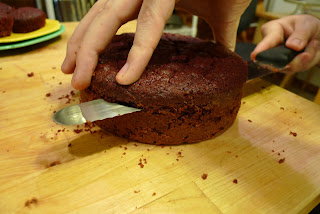Zucchini Risotto
2-3 large or 4-5 small zucchini cut into 1/2-inch slices
approximately 3 T chopped onion
1 clove garlic, finely chopped
2 T vegetable oil
2 T butter
2 cups arborio rice
1 cup broth + 4 cups water
salt to taste
1/3 cup freshly grated parmesan cheese
Put the chopped onion and 2 Tablespoons of oil into a large pot (we used our new dutch oven). Turn heat to medium-high, and heat until the onion starts to become transparent. Add the garlic and heat until it starts to color. There's a lot of cooking still ahead, so err on the side of undercooking the onion and garlic at this point.
Next add the zucchini, and turn the heat to medium low. Cook for about ten minutes, turning the zucchini occasionally so that they cook evenly. Add a pinch of salt, and continue to cook for approximately 15 more minutes, until the zucchini turn a nice golden color. While the zucchini is cooking, bring 1 cup of canned/boxed/whatever broth plus 4 cups water to a steady simmer in a pot right next to your risotto.
Once the zucchini is done, add one tablespoon of butter. After the butter melts, add the rice and stir to coat it well with butter. Turn the heat to high, and ladle in approximately 1/2 cup of simmering broth. From this point on, stir constantly!
Scrape the sides and bottom of the pot to prevent the rice from sticking. Whenever most of the liquid has been absorbed by the rice/boiled away, add another half cup. If you run out of broth, heat up some more water and keep adding it to the rice. The temperature in the risotto pot should be fairly high, so that the broth continues to boil when you add it to the risotto pot, but turn it down if it seems to be boiling away too quickly.
The risotto will be done when the rice is soft (not crunchy!) but still has a little bite to it--don't let it overcook into mush. This should take approximately 20 minutes. As it gets closer to done, add the broth in smaller increments so you don't accidentally end up with soupy risotto. The goal is for a risotto that's still wet, but not runny and gross.
When the rice tastes just slightly underdone (approximately 2 minutes before it's done, according to Marcella Hazan--I guess you learn how to time it that exactly from experience?) stir in the second tablespoon of butter and the grated parmesan cheese, and stir! Once it's cooked, remove it from the heat and add salt if needed. I added at least a half teaspoon of salt, probably. Don't leave this step out--the difference between under-salted and correctly salted was really obvious--all of the flavors become stronger, but it doesn't actually taste "salty."
Serve with additional grated parmesan on top. Leftover risotto is significantly less delicious than fresh risotto, so eat up! If you do reheat leftover risotto, be sure to add a little more water so it doesn't get dried out and gluey. The internet tells me that you can make some sort of pancake out of leftover risotto, so perhaps that will be my next recipe!















